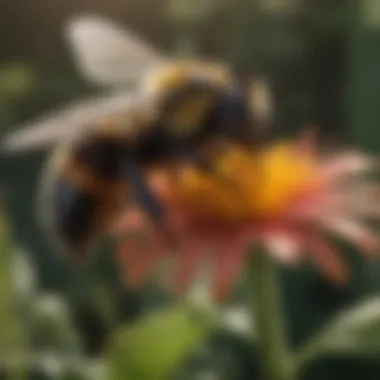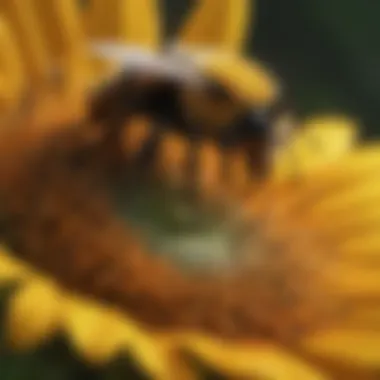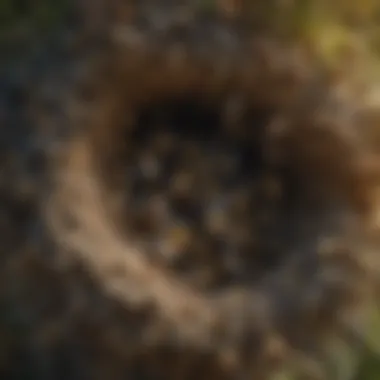The Bumblebee: Nature’s Complex Pollinator


Intro
Bumblebees are essential players in the ecosystems they inhabit. Their complex roles extend beyond simple pollination, engaging deeply with various plant species and even affecting food production in agriculture. Understanding these insects involves studying not only their behavior but also the critical functions they serve within ecological systems.
Given the pressing threats they face today, from habitat loss to climate change, there is an urgency to comprehend their ecological importance. This article aims to provide a detailed examination of bumblebees, exploring their social structures, the challenges they encounter, and the conservation efforts underway to protect them.
Understanding Bumblebees
Bumblebees serve a crucial role in ecosystems worldwide. By examining their biology, behavior, and the threats they encounter, we gain a comprehensive understanding of their significance. This section highlights how understanding bumblebees can enhance our conservation efforts. Knowledge about their ecological roles can lead to better policy decisions and informed public awareness campaigns, ultimately preserving both the bumblebees and the environments they inhabit.
Biological Classification
Taxonomy of Bumblebees
The taxonomy of bumblebees is essential for studying their diversity and ecological roles. Bumblebees belong to the genus Bombus, within the family Apidae. One key characteristic of this taxonomy is its reflection of evolutionary relationships. Classifying bumblebees allows researchers and conservationists to identify and monitor species accurately. This classification is beneficial for conservation efforts because it aids in recognizing at-risk species.
A unique feature of bumblebee taxonomy is its complexity; there are over 250 species worldwide, each adapted to specific environments. Understanding this taxonomy can be a challenge in the article, yet it provides crucial information for effective biodiversity conservation.
Physical Characteristics
The physical characteristics of bumblebees play a vital role in their identification and understanding of their behavior. Generally, bumblebees are characterized by their fuzzy bodies and vibrant colors which serve as camouflage and warning signals. A significant trait is their size variation, with some species like the Bombus terrestris being larger than others such as the Bombus muscorum. This diversity is beneficial as it reflects their adaptability to various environments.
Another unique aspect is their capacity to thermoregulate. Bumblebees can raise their body temperature, allowing them to forage in cooler conditions. This adaptation is advantageous as it increases their activity period during the day, enhancing their efficiency as pollinators.
Life Cycle Stages
Understanding the life cycle stages of bumblebees is critical for grasping their reproductive strategies and population dynamics. The life cycle typically consists of four stages: egg, larva, pupa, and adult. A key characteristic is the distinct role of the queen bumblebee, which is crucial for colony establishment in spring. This early-stage reproduction is a beneficial aspect to explore, as it reflects how bumblebee populations can recover after declines.
A unique feature of their lifecycle is the seasonal variation in reproduction. For instance, bumblebee populations can fluctuate dramatically between seasons. While their life cycle offers advantages to the species, it also poses disadvantages during unfavorable environmental conditions. Understanding these stages allows us to track population health and establish conservation measures effectively.
Species Diversity
Identifying Common Species
Identifying common bumblebee species helps connect their ecological functions to local environments. A defining characteristic is the ability to distinguish between various species based on their color patterns and morphology. This identification is beneficial for research and for conservationists working in local ecosystems. Recognizing which species are prevalent can facilitate targeted conservation efforts, particularly when addressing declining populations.
The unique feature of bumblebee diversity lies in their specialization; for instance, certain species thrive in urban ecosystems, while others are adapted to rural or wild habitats. This diversity has implications for their ecological roles and the types of plants they pollinate.
Habitats of Different Species
The habitats of different bumblebee species vary, linking their survival to specific environmental conditions. Each species has adapted to thrive in different climates and landscapes. A key characteristic is the crucial relationship between habitat availability and species richness. Understanding these habitats is beneficial because it allows for targeted habitat preservation.
A unique aspect to note is the influence of urbanization on bumblebee habitats. Some species may adapt to urban settings, while others are highly sensitive to habitat changes. Discerning these variances helps inform conservation practices.
Global Distribution
Global distribution of bumblebee species provides insight into their ecological roles across different regions. Bumblebees are found on every continent except Antarctica, demonstrating their adaptability. A major characteristic of their distribution is their prevalence in temperate climates, which support diverse flora.
This knowledge is beneficial, as it can assist in predicting how bumblebee populations may respond to global climate changes. A unique feature of bumblebee distribution is the impact of localized extinction. In some regions, specific species face threats that do not affect others, underscoring the importance of regional conservation strategies.
Bumblebee Behavior
Understanding the behavior of bumblebees is crucial to appreciate their role in ecosystems. Their actions dictate not only their survival but also the health of the plants they pollinate. By studying their foraging patterns and communication methods, one can grasp how these creatures contribute to biodiversity. This knowledge is essential for developing effective conservation strategies that can mitigate their decline.
Foraging Patterns
Nectar and Pollen Sources
Nectar and pollen are fundamental for bumblebees. They seek these resources to sustain their colonies and facilitate reproduction. Flowers provide diverse nutrient sources, each influencing bumblebee health and productivity differently. One key characteristic of these sources is their variability; some flowers offer abundant nectar, while others may be rich in pollen only. Bumblebees tend to make foraging decisions based on the reward size and availability. A unique feature of nectar source selection is the bees’ ability to gauge nectar volume, choosing to visit blooms with higher quantities. However, reliance on certain plants can lead to food scarcity, affecting populations during bloom shortages.


Seasonal Variations
Seasonal variations play a significant role in how bumblebees forage. Different times of the year yield distinct flower types, which influence the bumblebees’ dietary options. For example, in early spring, bumblebees may rely on crocuses, whereas summer bees often target sunflowers. This adaptability is crucial for their survival and reproduction. A significant advantage of understanding these patterns is that it allows for informed management of pollinator habitats. However, changes in climate can disrupt these patterns, leading to misalignment between bumblebee activity and flower availability, which poses risks to their survival.
Flower Preferences
Bumblebee species show clear preferences for specific flowers, dictated by several factors such as color, shape, and scent. These preferences are crucial, as they affect pollination rates of particular plant species. A popular choice among bumblebees are tubular flowers, which allow for easy access to nectar. This leads to effective pollination, benefiting both the plants and the bees. Unique features of flower preferences can increase biodiversity in local ecosystems. However, overreliance on certain flowering plants can reduce genetic diversity within bumblebee populations, leading to ecological vulnerabilities.
Communication Methods
Vibrational Signals
Vibrational signals are an important aspect of bumblebee communication. These subtle movements allow bees to convey information about food sources and threats to their colonies. The vibrations can indicate the presence of nearby flowers rich in nectar. This form of communication is advantageous as it does not require visual contact, making it effective in dense habitats. However, reliance on vibrations can also make them susceptible to disturbances that disrupt these signals, impairing foraging efficiency.
Chemical Communication
Chemical communication is another key aspect of how bumblebees interact. They release pheromones to signal alarm or to attract mates. This form of communication enhances colony cohesion. A defining characteristic is that pheromones can convey complex information rapidly, helping bumblebees coordinate activities efficiently. However, the presence of pollutants can disrupt these chemical cues, leading to disorientation and decreased colony health.
Social Interactions
Social interactions within bumblebee colonies dictate their behavior and efficiency in foraging. Bumblebees exhibit intricate social structures, working together during revelatory tasks such as nest protection and foraging. This organization promotes cooperation and resource sharing. A key advantage of understanding social interactions is that they provide insights into how colonies can thrive in changing environments. However, external stressors like habitat loss can strain these interactions, endangering the overall health of the bee population.
These behaviors not only support bumblebee populations but also reinforce the overall health of ecosystems.
Ecological Importance
Bumblebees play a crucial role in the functioning of ecosystems. They are not just important for their ability to pollinate plants but also for the intricate relationships they foster within the environment. Their contributions enhance both biodiversity and agricultural productivity, highlighting their significance in maintaining ecological balance. Understanding their ecological importance allows us to appreciate the broader impacts they have on plant communities, food systems, and ultimately human survival.
Pollination Mechanisms
Role in Agricultural Systems
Bumblebees are pivotal in agricultural scenarios, where they aid in the pollination of various crops. Their unique ability to pollinate under cooler conditions and their effectiveness with a wide range of flowers make them essential for maximizing crop yields. This depends heavily on their efficiency and adaptability. Because they can visit numerous flowers in a single foraging trip, their role significantly boosts agricultural productivity. Moreover, their pollination services extend beyond just single crops; they improve yields across many different species grown in proximity.
Impacts on Wild Plant Communities
The influence of bumblebees extends to wild plant communities as well. They help maintain genetic diversity by ensuring cross-pollination among plants. This genetic mixing supports resilience in ecosystems, allowing plants to adapt to changing conditions. If bumblebee populations decline, we may see reduced seed set and genetic variety in plants, which is detrimental to ecological balance.
Interactions with Native Flora
Bumblebees have complex interactions with native flora, often forming mutualistic relationships. These interactions support not just the plants but also other species relying on them, creating a web of ecological interdependencies. When bumblebees are present, native plants can thrive, ensuring that the local flora remains diverse and resilient. However, the decline in bumblebee populations can disrupt these established relationships, leading to significant ecological consequences.
Biodiversity Contributions
Supporting Ecosystem Functions
Bumblebees significantly bolster ecosystem functions by promoting plant diversity. Their activities ensure that various plant species can reproduce effectively, leading to lush habitats that support a range of other species, including birds and insects. This breadth of interaction creates a more robust ecosystem, crucial for its sustenance. Having diverse plant life increases habitat availability and food resources for many organisms, directly linking bumblebees to overall ecosystem health.
Enhancing Plant Reproduction
Through their pollination efforts, bumblebees significantly enhance plant reproduction. This process is vital, especially in ensuring the continuation of flowering plants that are the foundation of food webs. Plants that are effectively pollinated are more likely to produce abundant seeds, which contributes to population stability of various species within an ecosystem. As such, bumblebees help maintain the flow of energy through ecosystems by aiding plant life.
Consequences of Bee Decline
The decline of bumblebee populations presents serious risks to biodiversity. A decrease in bee numbers leads to reduced pollination success, which can result in cascading effects on plant life. Many plants would struggle to reproduce, leading to fewer flowering plants over time. This loss not only affects numerous animal species that depend on these plants but could also disrupt local ecosystems completely. Understanding the potential consequences emphasizes the need for conservation efforts.
"The health of ecosystems is dependent on the interactions among species. Bumblebees are key players in these dynamics, affecting everything from plant diversity to the stability of food sources in agricultural practices."
Through their multifaceted roles in both natural and agricultural ecosystems, bumblebees exemplify the interconnectedness of life. Recognizing their ecological importance is essential for implementing appropriate conservation strategies.


Threats to Bumblebee Populations
Bumblebee populations face several significant threats that can jeopardize their survival and overall impact on ecosystems. Understanding these threats is crucial for developing effective conservation strategies. The decline in bumblebee numbers can negatively affect pollination processes that are vital for maintaining biodiversity.
Habitat Loss
Habitat loss is a leading cause of bumblebee decline. As human activities expand, natural habitats are fragmented or completely destroyed.
Impact of Urbanization
Urbanization has a profound effect on bumblebee habitat. This phenomenon often leads to the replacement of native flora with buildings and roads. Consequently, bumblebees lose access to essential food sources like nectar and pollen. The key characteristic of urban areas is their lack of biodiversity compared to natural environments. Urban settings cannot support the same variety of plants needed for bumblebee foraging. This makes urbanization a significant concern for pollinator health and survival. Urbanized landscapes also create barriers, making it difficult for bumblebees to migrate and find suitable habitats.
Agricultural Expansion
The expansion of agriculture further compounds habitat loss. Fields usually favor monocultures which provide limited resources for pollinators. A crucial element of agricultural systems, especially in modern practices, is the heavy use of chemical inputs. These practices alter environments profoundly, leading to decreased floral diversity. In many cases, agricultural lands prioritize high-yield crops over native plants essential for bumblebee populations. This reduction in habitat quality can severely limit bumblebee accessibility to food sources and nesting sites.
Climate Change Effects
Climate change poses a different threat, with numerous implications for bumblebees. As temperatures rise and weather patterns shift, the timing of flower blooming can become incongruent with bumblebee life cycles. The ability of bumblebees to forage effectively is compromised when floral resources are out of sync with their emergence. A vital characteristic of climate change is its unpredictability; it can lead to extreme weather events that further destroy habitats. Managing these effects is challenging, as they encompass a broad range of environmental changes.
Pesticides and Pollutants
Pesticides and environmental pollutants present another critical danger to bumblebee populations. These substances can have direct and indirect impacts on their health and survival.
Toxic Effects of Neonicotinoids
Neonicotinoids are a class of insecticides that have been linked to bumblebee mortality. The main aspect of neonicotinoids is their neurotoxic effects, which can impair navigation and foraging behavior. The key characteristic of these chemicals is their systemic nature, as they affect the whole plant and exposure can occur even indirectly through pollen consumption. This widespread use of neonicotinoids is an essential point of concern for this article, given their detrimental effects on bee populations and broader ecological ramifications.
Environmental Contaminants
Environmental contaminants, including heavy metals and industrial runoff, also threaten bumblebee health. Such pollutants can contaminate habitats and affect food sources. The unique feature of these contaminants is that they often persist in the environment, accumulating over time. This accumulation can lead to long-term impacts on bumblebee populations as the toxic effects can weaken immune systems and reduce reproductive abilities. Understanding these threats is critical to address environmental health for all species, including pollinators.
Regulatory Measures
There has been increasing awareness of the threats posed to bumblebees, leading to calls for regulatory measures. These measures aim to limit harmful pesticide use and promote practices that protect bumblebee habitats. A key characteristic of these regulations is their focus on creating sustainable agricultural practices. They promote pesticide alternatives and encourage organic farming methods. Moreover, regulatory measures can help restore and maintain habitats to support bumblebee populations. The implementation of such measures is crucial for safeguarding biodiversity and fostering ecosystem resilience.
"Protecting bumblebees is not just about saving one species; it is about maintaining the balance of our ecosystems."
Conservation Strategies
Conservation strategies for bumblebees are essential given their role in ecosystems and the multitude of threats they face today. As noted, bumblebees contribute significantly to pollination, which has positive effects on agricultural yields and biodiversity. It is vital to implement effective strategies that enhance their habitats and populations.
This section will discuss specific conservation measures and the benefits they hold for the overall health of these crucial pollinators.
Habitat Restoration
Creating Pollinator-Friendly Spaces
Creating pollinator-friendly spaces involves designing environments where bumblebees can thrive. This approach directly contributes to the conservation efforts detailed in this article. A key characteristic of these spaces is the inclusion of a diverse range of flowering plants, which provide essential nectar and pollen resources. This diversity attracts bumblebees and supports their health and reproduction.
The unique feature of pollinator-friendly areas is that they can be integrated into various settings, such as urban gardens, parks, and agricultural landscapes. The advantages include not only enhanced pollinator populations but also improved aesthetics and environmental quality in the surrounding area. However, one disadvantage is the need for ongoing care and management to maintain these spaces effectively.
Native Plant Selections
Native plant selections involve choosing plant species that are indigenous to a certain region. This choice is beneficial because native plants are well-adapted to local climate and conditions, and they often have co-evolutionary relationships with local pollinators, including bumblebees. The inclusion of native species helps ensure that these plants flourish and provide stable food sources.
A unique aspect of selecting native plants is their capacity to support local ecosystems as well as bumblebee health. They can resist pests and diseases better than non-native species, reducing the need for chemical pesticides. The drawback is that finding suitable native plants can be challenging in some regions, and it may require educational campaigns to inform communities about their importance.
Community Involvement
Community involvement in conservation efforts is critical. Engaging local residents in creating and maintaining bumblebee habitats can lead to long-lasting success. A key characteristic of community involvement is the collective action that fosters a sense of stewardship. Many individuals can contribute through local gardening initiatives, educational events, or habitat restoration projects.


The unique feature of community involvement is how it builds awareness and appreciation for bumblebees and their ecological roles. When communities collaborate on these efforts, it also strengthens social ties and local identity. Still, a potential disadvantage is that success often depends on sustained volunteer effort, which can wane over time without ongoing motivation and support.
Research and Monitoring
Tracking Population Trends
Tracking population trends is important for understanding the health of bumblebee populations over time. This strategy involves systematic data collection and analysis, which can help identify declines or increases in specific species. A central characteristic of this method is the use of citizen science, where volunteers contribute data on sightings and abundance.
The unique feature of this approach is that it provides a wealth of data that often exceeds what scientists can collect alone. However, it requires reliable methods for data validation, as volunteer-collected data can vary in accuracy. Despite these challenges, monitoring population trends remains a crucial part of conservation work.
Policy Development
Policy development plays a decisive role in the protection of bumblebee populations through legislation and regulations. Good policies can shape land use, promote sustainable agricultural practices, and limit harmful pesticides. A key characteristic of this strategy is the collaboration between scientists, policymakers, and conservationists to formulate effective measures.
The unique aspect of policy development is its potential for widespread impact; legislation can affect large areas and many habitats. However, there can be obstacles like political resistance and the need for comprehensive research to guide policy decisions.
Educating the Public
Educating the public about bumblebees and their importance to ecosystems cannot be overstated. Through awareness campaigns, workshops, and informational resources, communities can learn about actions that help bumblebees. A central characteristic of public education is the dissemination of clear, accurate information that motivates people to support conservation efforts.
The unique feature of this approach is its capacity to foster a change in mindset. When people understand the critical role bumblebees play in our world, they are more likely to engage in conservation actions. Nonetheless, challenges persist if the communication does not resonate with diverse audiences; therefore, adaptability in messaging is key to effectiveness.
Engaging with Local Ecosystems
Engaging with local ecosystems is crucial for enhancing the biodiversity that bumblebees rely on. This process involves communities taking an active role in monitoring and contributing to the health of their natural surroundings. As ecosystems become more fragmented, the engagement at a local level becomes essential.
By connecting communities with their environments, people can foster understanding and respect for bumblebees and their integral role in pollination. Local involvement can lead to improved conservation strategies and increased public awareness regarding the challenges these species face. It cultivates a sense of stewardship among citizens, encouraging long-term sustainability.
Citizen Science Initiatives
Participating in Local Surveys
Participating in local surveys allows citizens to contribute directly to bumblebee research. This activity assists in gathering data on bee populations, their habitats, and their behaviors. It helps scientists to track trends over time, which is vital for conservation efforts. Local surveys often involve simple methods, making them accessible to a wider audience.
This initiative stands out for its ability to engage non-specialists in important scientific work. One unique aspect is how these surveys can foster community collaboration and involvement. They can boost local pride and recognition of native species. However, there may be challenges, such as the need for adequate training and resources to collect quality data.
Contributing to Data Collection
Contributing to data collection provides a structured way to gather valuable information on bumblebee populations. Various platforms allow citizens to input their observations, which scientists can then analyze. This aspect of citizen science is valuable because it contributes to a larger dataset that can influence ecological research and policy.
Data collection is popular because it democratizes science. Every observation counts, and it shows how collective efforts can lead to significant, impactful results. A unique feature of this approach is its capability to span geographical areas, gathering information from diverse environments. One downside may be the potential for inconsistent data quality, but proper guidelines can mitigate this problem.
Community Outreach Programs
Community outreach programs play a significant role in promoting awareness about bumblebees and their habitat needs. These programs encourage local populations to understand the importance of bumblebees in pollination and broader ecosystem health. They often include workshops and educational events to teach effective conservation practices.
The key characteristic of outreach programs is their adaptability to local contexts. By tailoring messages to specific communities, they can resonate more deeply. A unique feature is the combination of education and action, which empowers citizens to advocate for their environment. A challenge might include varying levels of community interest or engagement, which can impact program effectiveness.
Personal Action Steps
Supporting Native Flora
Supporting native flora directly benefits bumblebee habitats. Native plants provide essential food sources like nectar and pollen, crucial for their survival. Additionally, native species can often adapt better to local conditions, making them more resilient.
Encouraging people to plant native flora creates a network of food sources for bumblebees. This effort is popular because it requires minimal effort and can be integrated into home gardens. One particular advantage is that native plants frequently require less maintenance once established. A possible disadvantage is that visitors might prefer non-native plants for ornamental purposes, which do not support local species as effectively.
Limiting Pesticide Use
Limiting pesticide use is a fundamental step in promoting a healthy environment for bumblebees. Pesticides can have harmful effects on bee populations, contributing to their decline. Encouraging less toxic, organic alternatives can mitigate these impacts.
This measure is beneficial as it not only protects bumblebees but also enhances overall ecosystem health. Many communities have started initiatives to reduce pesticide reliance, demonstrating a collective responsibility. A unique feature of this approach is its sustainability, as it promotes environmental consciousness. However, transitioning away from chemical pesticides can be a slow and challenging process, particularly in agricultural areas.
Advocating for Policy Change
Advocating for policy change is key to establishing supportive environments for bumblebees. Citizens can influence local governance by promoting policies that protect pollinators. This involvement is vital for creating long-term solutions.
The critical characteristic of this step is its ability to channel community concerns into actionable frameworks. A key advantage is that policy changes can lead to significant improvements in habitat protection on a broader scale. However, the process may involve lengthy discussions or confrontations, which could discourage some participants.



